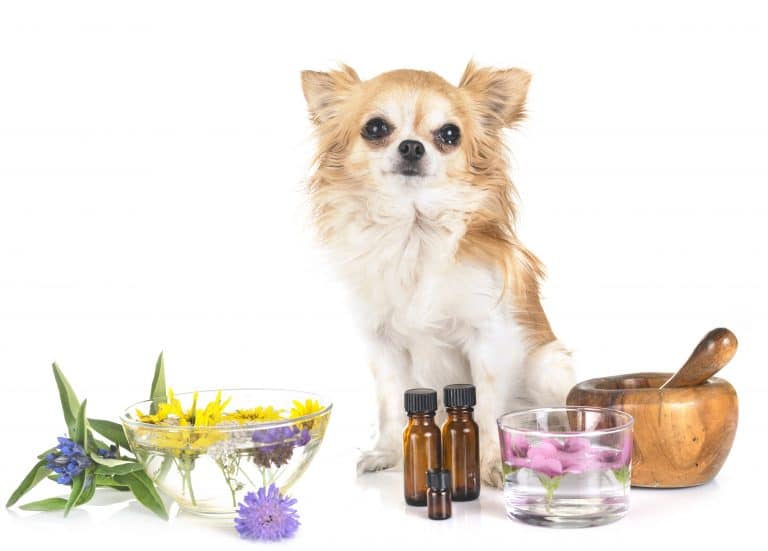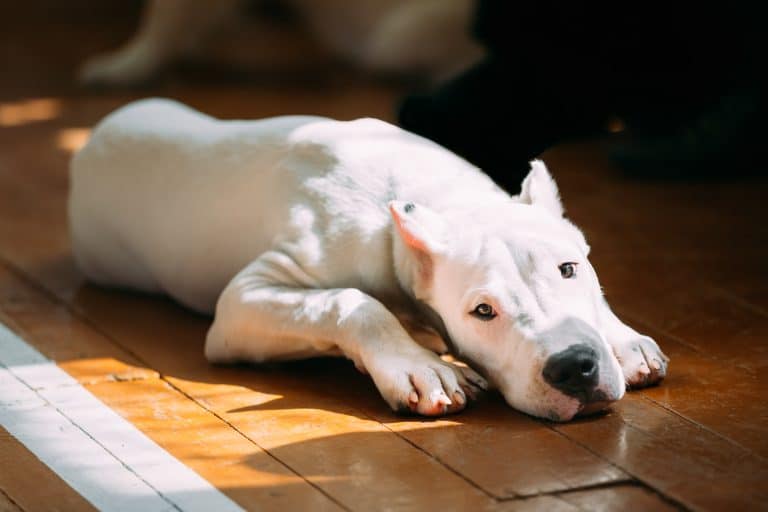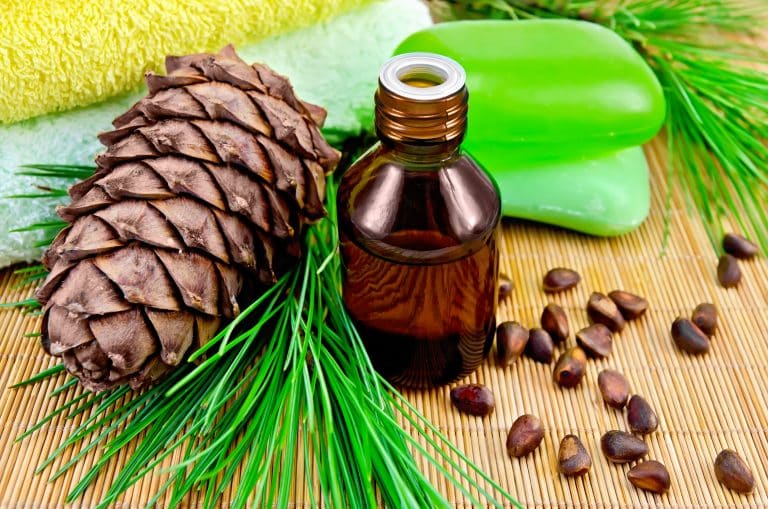Certified content.
This guide has been written and verified by our veterinary advisor.
Approved By: Dr. Joanna De Klerk.

Dr. Joanna De Klerk
Photo Credit: https://www.express.co.uk
As a vet with a specialty in pain management, I see dogs (and other animals) daily with creaky joints, overtired or compensating muscles, and itchy skin conditions.
I am regularly faced with the complication that these poor dogs are either old, or have underlying health conditions. This means dispensing pain relief or steroid medications may cause further complications. Therefore, I started looking into complementary ways to treat them so that I could use the minimal amount of medications possible.
That is when I was introduced to the world of essential oils for dogs.
I now use them on a daily basis in my line of work, to provide massages for pain, as well as make up shampoos and creams to help skin. Since I’ve been doing that, the results have been incredible!
What Are Essential Oils? And Why Should You Consider Them?
According to the American Kennel Club:
Preliminary research suggests that these potent oils may have some health benefits for dogs and humans, and many holistic veterinarians incorporate essential oils into their practices.”
So, what are they?
Essential oils are compounds which have derived from plants.
They are the aromatic substances found in these plants which give them their incredible smell. These compounds are harvested from the plants by a means of cold-pressing or distillation, using steam or water.
Historical records suggest that the Egyptians were the first people to discover distillation techniques for essential oils. Once extracted, they are usually diluted and blended with a carrier oil, not only to make them easier for use, but to also make them safer to use.
They are highly volatile, and lipid soluble, meaning that they can be easily absorbed through the cell membrane into cells in the body. This means when they come into contact with skin, they are immediately absorbed into the skin and structures below. They can also be used for aromatherapy, as it has been proven that essential oils stimulate the limbic system in the brain. This is the area of the brain which controls emotions, as well as some unconscious functions, such as breathing, heart rate and blood pressure.

How are essential oils going to benefit your furry friend?
There is still a lot of scientific research to be done on the subject of essential oils, but they have been proven to have many desirable health benefits. These include anxiety reduction, anti-inflammatory properties, anti-oxidative, anti-bacterial, anti-viral and anti-fungal effects.
They can also potentially alter memories and mental states, and exciting research is currently being done to see whether they can be used to combat resistant infections and cancer.
How do you use essential oils on your dog?
For starters, you should always use essential oils under the direction of your veterinarian. Whilst they are natural products, they can still have remarkably potent effects, and so you should let your veterinarian know that you are using them.
Essential oils should always be used topically, meaning on the skin, or via inhalation as aromatherapy. Tips on how to make up different preparations and blends are given later on. The jury is still out regarding ingesting essential oils; however, the general consensus is that it is not safe, despite some promising studies regarding their effects.
Are Essential Oils Safe for Dogs?

Before you think that it all sounds great, and rush out to get some essential oils for your dog, it is worth pausing for a second to understand the safety aspects. Yes, they have profound health benefits, however, with their potency also comes some very real side effects.
Therefore, it is important to follow these safety tips when using essential oils on your dog:
- Always ensure your veterinarian is on board with you using essential oils. For some dogs, they may exacerbate health issues, or interact with other medications. For example, dogs who are prone to epilepsy, may have more seizures when exposed to essential oils as they can reduce the seizure threshold in the brain. Your veterinarian will be able to advise you whether it is safe to use them on your dog.
- If you also own cats, as well as dogs, you should use essential oils with extra caution. Cats do not have the liver enzymes needed to metabolize essential oils, meaning that they are at a higher risk of toxicity. If your dog and cat are great friends, then grooming each other could be dangerous.
- When applying essential oils to the coat of your dog, ensure they are diluted in a carrier oil or water, as if they are pure, they might cause skin irritation. Also, in a more concentrated form, they could cause toxicity if licked off and ingested.
- If you are using essential oils for aromatherapy purposes for either yourself or your dog, always ensure that your dog has access to part of the house where he can get away from the smell. Dogs have greatly heightened olfactory senses compared to humans, and therefore the scent can easily become over-bearing for them.
- Always purchase pure essential oils. Cheap essential oils may contain additional chemicals, which could bring harm to your dog.
- The concentrated forms of the oils should always be kept out of access to your dog. If they were knocked over on him or he chewed the bottles, it could cause serious side effects.
- Finally, when applying them to your dog, never use them around the eyes, nose or genitals, nor on puppies under 10 weeks, pregnant or nursing dogs.
As well as these safety guidelines, there are also some essential oils which are not suitable for your dog as they may cause toxicities. A list is given later on. So, it is important to do your research into which oils to use and how to use them to ensure you are benefiting your dog with them.
What Are Common Things for Which You Can Use Essential Oils for Dogs?
Fleas & Ticks

A common use for essential oils is as a repellent for external parasites, such as fleas. It is a common misconception that essential oils will treat fleas, as they do not kill them, but simply repel them. However, combined with daily monitoring and brushing, their use may avoid needing to apply monthly medications to treat external parasites.
With that being said, if your pooch has a problem with flea infestation, is it best to seek the advice of your veterinarian for the appropriate treatment to kill them both on your dog and in the home.
Essential oils which appear to be effective against repelling these parasites include eucalyptus, lavender, cedar oil and white cypress. These do not need to be all mixed together, as just one or two in the blend will be effective.
There are several methods you can use to make a flea repellent for your dog.
The first is by dropping the diluted oils onto a bandana, which your dog can wear 24/7. The oils need to be topped up once a week to stay effective.
Another method is to dilute the oils and place them on the body of your dog around the tail. This is where fleas are most commonly found and therefore it is a good site for concentrating the application. The downside to this, is that it is an easy area for your dog to lick.
Finally, the most popular method is to combine 1 cup of apple cider vinegar with 1-quart water and add 2-3 drops of your chosen oil. Give this a shake and mist your dog three times per week using a spray bottle, taking care not to spray it in the face or on the genitals.
Ear Infections

Ear infections can be terribly sore and therefore keeping the ears clean will help prevent ear infections. If an infection were to happen, the good news is you can aid in its healing with essential oils. These can either be used as a preventative, in a cleansing solution, or they can be used in conjunction with medicated ear drops to speed up the healing.
They should not be used instead of routine treatment, as ear infections can quickly progress and cause your dog extreme pain, therefore withholding medicated ear drops is not in your dog’s best interests.
The most common symptoms you will see when your dog has an ear infection include scratching and shaking the head. You may also see discharge from the ear, which could be pus or waxy discharge, and reddening. If you are noticing these signs, you will need to get your dog medicated drops from your vets, which can be helped along with an essential oil cleanser.
If your dog does not have an ear infection, then it is still good to use an essential oil cleanser to keep the ears clean and free from bacteria. This is especially important if you have a dog with floppy ears or that likes to swim.
The best way to make up an ear cleansing solution is to purchase a neutral ear cleanser from your local pet store or veterinary practice, and add a couple of drops of lavender, frankincense, geranium or basil.
Allergies

Allergies are a complex topic, and no two dogs will be allergic to the same thing, so it is impossible to say that there is an essential oil recipe that will cure all allergies. It is better to work alongside your veterinarian to determine the underlying cause for your dog’s allergies, as prevention is better than cure.
With that being said, essential oils can be very useful in taking away the itchiness in the skin when during an allergic reaction. You can easily make up an oily spray by mixing a few drops of essential oils with cold pressed olive oil. Essential oils which are particularly good at soothing the skin include chamomile, helichrysum, lavender, and sweet marjoram.
Anxiety

It is easy for your dog to become nervous for many reasons. It might include phobias, such as thunderstorms, separation anxiety, fear-related aggression or transition periods, such as adding a new dog to the household or moving house.
This is a prime example of when aromatherapy can be very useful. Oils such as lavender, vetiver, and myrrh are all effective at reducing anxiety.
Muscle Aches

Many people, when they think of essential oils, think of massage. And that’s exactly how I got into using them. I have a specialist interest in pain management, and massage is an excellent way of improving blood flow to tired, aching muscles, and to remove all the lactic acid build up in them.
When a dog has a joint issue, such as arthritis, or an injury to a limb or their back, they change the way they walk to relieve the pressure on those sore areas. This in turn causes certain muscles to overcompensate and become sore. By massaging them with diluted essential oils, it allows you to bring about some relief, so that they can move in a more pain-free manner.
Essential oils such as peppermint, helichrysum, copaiba, cypress, marjoram and frankincense are all excellent at soothing muscles and improving blood flow.
There are several massage strokes which you can do with your dog, which are easy to teach and perform at home.
Before the massage, start with some mild compression of the muscles. After this, the first massage is a stroke called ‘effleurage’. This is simply a firm and long stroke which improves blood flow and relaxes muscles. Then the main stroke of the massage is called ‘petrissage’, which is more of a kneading action. This video demonstrates canine massage excellently.
But is massage simply for dogs with creaky or sore joints? Absolutely not. Any dog over the age of eight will benefit from massage. Many people are not aware that one in five dogs above the age of eight have mild arthritis, with very few visible symptoms. Therefore, I think it is always best to give your dog the benefit of the doubt. Regardless, even if your dog is fine, he will still enjoy it!
10 Best Essential Oils That Are Safe for Dogs
So, which oils should you use on your dog? For most dogs, it is trial and error to see which ones work best for them, but here is a list of ten essential oils which are safe for you to dilute and use alone or blend together.
Lavender oil

Lavender is a very popular oil, both for humans and dogs. Its uses are extensive and it can be very effective on its application.
One of the main uses of lavender oil is for its anti-anxiety effects. In 2006, there was a study performed looking at how lavender can influence the behavior of dogs that experience travel-induced excitement. The study included 32 dogs, and proved that those using lavender aromatherapy experienced significantly more time sitting and resting during the journey.
(1)
Lavender oil also has excellent soothing effects as well as anti-bacterial properties, and so it is a common choice for adding to blends which are applied to skin concerns, such as wounds, allergies and infections.
Peppermint Oil

Peppermint oil is a very popular oil to find in lotions and gels, which have been pre-prepared and sold in pet stores and vet practices.
According to veterinarian Dr. Janet Roark, aka the ‘Essential Oil Vet’,
Peppermint essential oil can be used to cool sore muscles, energize tired animals, and soothe upset stomachs. It refreshes the air when diffused. This oil can open the airways and promote a healthy respiratory tract, as well as soothe aching joints.”
Chamomile Oil

Chamomile oil is a gentle oil which helps relieve stress. It also has incredible anti-inflammatory therapeutic benefits, which are useful for burns, skin disorders, irritation and wounds.
(2)
Chamomile can easily be used in a calming room spray, in a blend with lavender oil, to provide your dog with a sense of relief from any anxiety which he may be experiencing.
Frankincense Oil
Frankincense oil is considered a super oil, as it tackles so many different health ailments within the body. The most notable is its potent anti-bacterial, anti-viral and anti-fungal properties. It also helps to boost the immune system.
It has also been proven in mice, through a study in 2008, that frankincense can provide anti-depressive effects.
(3)
Cedarwood Oil

Cedarwood oil is particularly useful if your dog has a cough. It is an expectorant, which means it helps to loosen the mucus, and is particularly good for phlegmy infections like kennel cough. Naturally, it needs to be breathed in for this effect, so is best used in an aromatherapy setting.
It can also be used in a massage oil for the coat, as it improves circulation to sore muscles, acts as a calming agent, and helps boost hair growth, to aid with a lush, glossy coat.
Cardamom Oil

Like cedarwood oil, cardamom oil can also aid in improving coughs or other infections. It has potent antimicrobial properties which will help get on top of the lung infection when breathed in. It can also be used topically for local infections.
In addition to this excellent application, it is very useful in improving appetite and reducing nausea, so if your dog is not feeling too well, put a few drops of diluted oil on a bandana or in a diffuser to allow your dog to breathe it in.
Helichrysum Oil

As you’ve already read, there have been many applications for which helichrysum oil has been recommended. It is an excellent oil for many uses for two separate reasons.
effect on the circulatory system. It boosts the health of the heart, improves blood flow and decreases bleeding. Secondly, it is particularly effective when applied to the skin in a massage oil or spray application. As it soaks in, it rejuvenates it and improves the skin barrier. As a result, it enables the skin to be a better barrier against external allergens and infections.
Spearmint Oil

Don’t be fooled that since spearmint and peppermint are both from the mint family, that they do the same thing. In fact, they have remarkably different applications.
Coming into contact with spearmint oil, can aid in balancing metabolism and reducing nausea, so it is particularly good for dogs which are struggling with gastrointestinal issues. Some people suggest that this oil can be ingested in small quantities, however we suggest that you always stick to either aromatherapy or topical applications for essential oils, as it is easy to cause a toxicity.
Copaiba Oil
If you aren’t sure of what oil to use or blend, then you cannot go wrong with copaiba. Its uses are endless. It boosts the immune system, and supports the cardiovascular, digestive, respiratory, musculoskeletal and nervous systems. As a result, it can improve blood flow, reduce pain, and improve general wellbeing.
Fennel Oil

Fennel oil has a sweet smell when used in aromatherapy, similar to that of liquorice. It is popular to use topically on areas where there is fluid build-up in the tissues, such as an area of inflammation, over a seroma or around a post-operative wound. This can be done when diluted into a massage oil.
With all essential oils, it is important to remember that each dog is an individual, and will react in a different way to the next dog. Therefore, if there are any adverse effects, all applications of oils should be ceased. The best way to prevent this from happening is to consult your vet before using any oils to get their advice you’re your specific dog.
How is quality determined?
Essential oils can be expensive, so if you are shopping around for the best price, it is important that you consider the quality of the oils on offer. The high price is because they require such a large amount of the raw ingredients, to extract even just a little bit of oil.
So, how do you ensure that you are buying an oil of high quality?
Unfortunately, the answer is ‘not very easily’. Even the most expert practitioners using essential oils will not be able to tell by just looking at it or smelling it.
Instead you must ask careful questions to determine the quality.
The following are questions to consider:
- Is it branded an ‘essential oil’? Or does it say it is a ‘fragrance oil, aromatherapy oil, or perfume oil’? The latter are all diluted forms.
- Does a dried drop of oil on a piece of paper soak into the paper or leave some oily residue? Essential oils will completely soak in once dried.
- Does the name suggest it is a synthetic compound? Synthetic versions may still smell the same, however they may not have the same therapeutic effects. For example, there is a difference between the natural ‘vanilla’ oil and synthetic ‘vanillin’ oil, despite the fact they smell identical.
- Is the oil organic? Essential oils are highly concentrated plant extracts, which means that any pesticides or chemicals used on the plants also may become highly concentrated within the oil.
- Is the company reputable? Chances are if you have never heard of the company, or that they sell their oils at bargain prices or for a flat rate, then they are not selling quality oils.
Essential oils that are toxic for dogs
Not all essential oils are suitable for using on dogs, and some are not recommended for any animal at all.
The following essential oils should be steered clear of for dogs:
- Clove
- Garlic
- Juniper
- Rosemary
- Tea Tree
- Thyme
- Wintergreen
And the following essential oils should not be used on any animal, in case you were hoping to use them on a different furry friend:
- Anise
- Birch
- Bitter Almond
- Boldo
- Calamus
- Camphor
- Cassia
- Chenopodium
- Goosefoot
- Horseradish
- Hyssop (Hyssopus sp. with the exception of Decumbens)
- Mugwort
- Mustard
- Oregano
- Pennyroyal
- Red or White Thyme
- Rue
- Santolina
- Sassafras
- Savory
- Tansy
- Terebinth
- Thuja
- Wormwood
- Yarrow
The Risks of Essential Oils
Because essential oils are natural, many people assume they are safe. However, they are extremely potent substances, and therefore if used incorrectly, they may cause serious side effects.
As discussed earlier, the essential oils are lipid soluble, which means they are easily absorbed into cells. For the body to remove them from the system, they must be metabolized by the liver. As a result, puppies, elderly dogs and dogs with liver disease may struggle to do this.
When applied topically, if you have not diluted the oil appropriately, then there is the possibility of causing marked irritation to the skin. In addition to this, your dog might lick it off, which can lead to gastrointestinal upsets.
The olfactory powers of a dog are hundreds of times better than ours as humans, and therefore what is a strong scent to us, can be overwhelming to them. As a result, if you are using essential oils for aromatherapy purposes, always check that it is not causing your dog undue stress.
Finally, the essential oils listed above are toxic to dogs, which can cause some serious health implications.
The following list are some of the symptoms which you might notice:
- Muscle tremors
- Lethargy or weakness
- Trouble walking or an uncoordinated gait
- Difficulty breathing
- Low body temperature
- Excessive salivation
- Vomiting
- Excessive pawing at mouth or face
- Drooling
- Redness or burns on the lips, gums, tongue or skin
If you suspect your dog has ingested an essential oil, call your veterinarian or Pet Poison Helpline (855) 764-7661 right away. Early intervention is best.
How Do You Apply Essential Oils for Dogs?
So now you know what to look out for when using essential oils,
how do you go about using them in the correct manner?
There are several types of preparation which you can use on your dog, which all involve dilution of the oils in another carrier oil or water.
Carrier Oils
If you are wanting to make up a massage oil, the best is to dilute the essential oils in a carrier oil. This can be any oil of your choice, but popular ones are olive oil, coconut oil or grapeseed oil. Approximately three drops of essential oil should be used per ounce of carrier oil.
Shampoo
If you have a neutral based shampoo, or a shampoo that you particularly like which you want to improve even further, you can add about 20 drops to eight ounces of shampoo.
Topical Sprays
A topical spray is useful for misting the skin with, or using as a room spray. The total amount of essential oil mixed in the water should not exceed 1%, however, even as little as 0.1% can be very effective.
Aromatherapy
To use the oils as aromatherapy around your dog, either apply just one drop of oil to your dog’s collar, or use an aromatherapy diffuser in your household.
Bottom Line
So now you know all about the use of essential oils in dogs. Isn’t it exciting that you can easily put this into practice in your very own home to improve the health of your furry friend? But just remember to carefully do your research when it comes to choosing which oils to use, the quantities you use, and the quality of your product, as mistakes can be made.
Remember to always consult with your veterinarian before using essential oils, and immediately contact them if you notice an adverse reaction. But try not to worry too much, as in the end, if you have followed our guidelines, then you should be greatly aiding in improving the health of your doggo!
Are you using essential oils on your dog? Which blend? And why? Share your story with us in the comments below.

One request from Speedy
Dr. Joanna De Klerk put so much effort writing this blog post to provide value to the dog parent community. It’ll be very helpful for me, if you consider sharing it on social media networks.
SHARING IS ♥️


